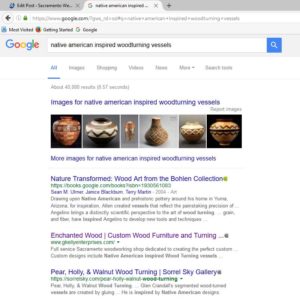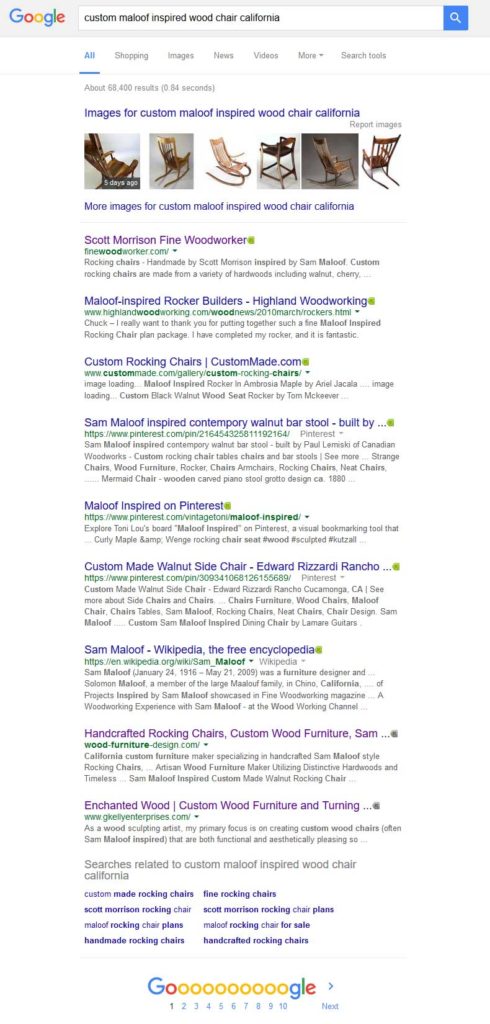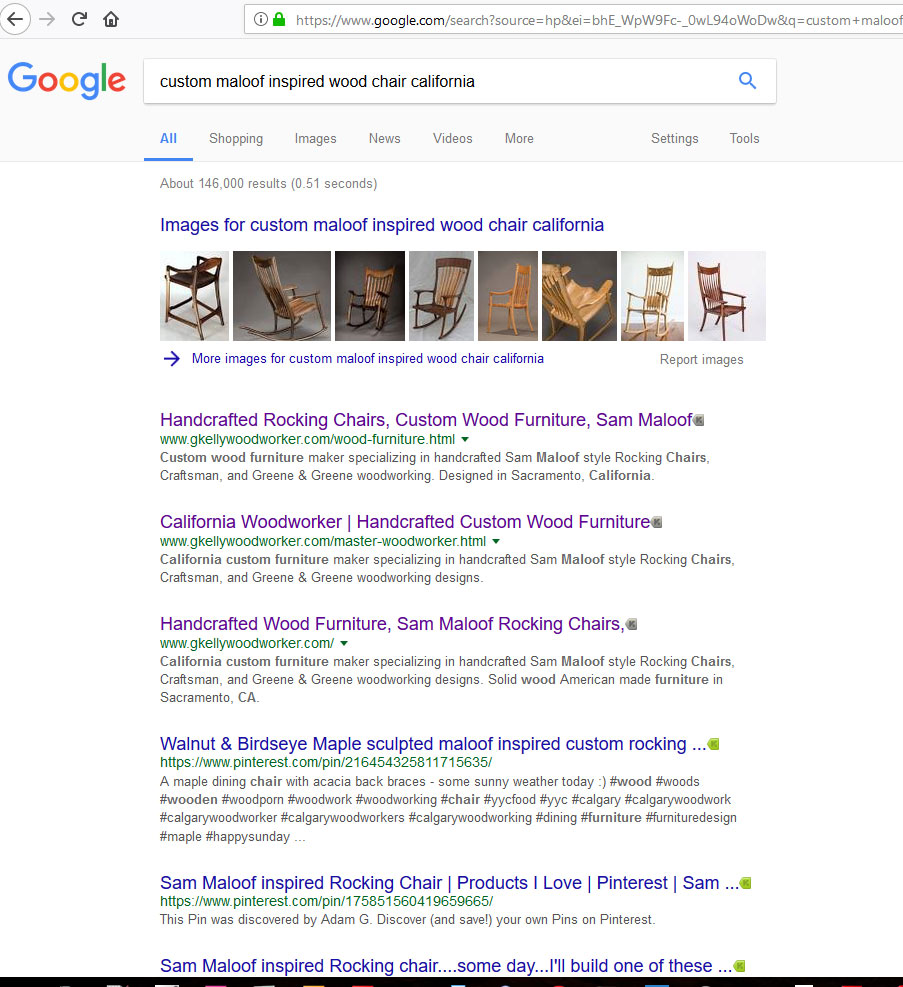I would imagine that most of you have a general understanding of the fundamentals of SEO by now, so this post is intended as a working example of how to get a new website to rank well, and what will affect that ranking. If you are yet unfamiliar with the basics then I suggest you start with https://www.ecurtisdesigns.com/seo-sem/ If you have additional questions after you read the SEO/SEM page I would suggest browsing our SEO category page at https://www.ecurtisdesigns.com/development/seo/
Okay, so the questions I am routinely asked are, if you optimize my web pages:
- Will I get on the first page of Google?
- Will I be in the top 5 of Google?
- Do I need to pay monthly to get a good ranking?
- Do I need to use Google AdWords?
The important question to ask is really, what is needed to get a good SEO ranking and stay there? To help answer this question I’ve written this post about a website I completed last week for a wood furniture designer who lives in Sacramento.
Gene’s Story: I had built a previous website for the client, “Gene”, a couple of years back that primarily featured his Native American Inspired Wood Turning Vessels since this was his “focus” at that time. If you searched “Native American inspired Woodturning Vessels” Gene’s website enchantedwood.com was the first result after the initial Google books link. 
UPDATE: Since I wrote this post Gene decided to change his domain to www.gkellywoodworker.com and to incorporate both his turnings and chairs on this website. Consequently the “enchatedwood.com” link is no longer active.
Gene’s site ranking was in the “top 5”, and yes, most businesses can expect this if they’ve had a domain for a while, have a good reputation (no spammy practices or suspect linking), and have enough text content with a good keyword density relationship.
The concern though was that Gene’s offerings also included custom furniture, and while I did target for furniture with SEO as well as Turnings, one can only target so much (the home page title only allows for about 8 words), so the best option for Gene was to move his furniture to a new website where it could be adequately featured.
The first question is, will a website do better on a new domain, or the existing domain? In most cases it is best to retain the existing domain for its established ranking value, unless the old domain has credibility issues, or the new domain is keyword specific, so has high SEO value. For Gene’s new website I did some researching and found “Wood Furniture Design” to be the best option since it was highly queried and it matched what Gene offers. We went with wood-furniture-design.com since the non-hyphenated was not available, and underscores are less common (and some say have less SEO value).
For the layout we had the option of the standard “static” website or a CMS (content management system). Knowing that Gene wasn’t going to want to make the site changes himself the best option was to use a standard HTML5 responsive layout since it is the most secure (sorry hackers) and the HTML5 framework allowed me complete control over every design element, which a CMS site only offers somewhat since each page is dynamically generated from template pages.
Having worked in the Interior design field for a couple of years myself I had a good idea of what I wanted visually, which I am pleased to note that I did achieve. One might argue that the design itself really won’t affect a page’s ranking, and that is true in part. I have certainly seen many horrendously ugly web pages rank at the top of a search listing, but the question I would ask is — Would you trust the business, service, or even news from the ugly or poorly developed website? I personally would keep searching without reading their content. The long and short is that a web page’s ranking is affected, in part, by how long a visitor spends on the page, repeat visitors, and sharing of it. A website that is attractive will certainly achieve more engagement than one that fails in visual ways.
Once I got the visual look and page layouts in place the SEO aspect happens naturally. The primary things I did for Gene’s website were:
- Responsive Design: Google awards SEO points to web pages that are responsive. This website is responsive, and it looks great in mobile. It is also important that the scripts used, and images, don’t slow the site down much or it won’t get indexed fully, and will lose lots of potential traffic. The contact phone number is also mobile optimized for “click to call”.
- SEO optimized page names: Page name have a big SEO impact, as does the navigation name. I ensured that there were keywords in both of these.
- SEO optimized page descriptions: The description meta-tag is what one typically sees in the Google search result (though sometimes page content is shown, though this can be overridden). I spent the time to ensure that the description added targeted that specific page, so was unique and of the correct length.
- SEO optimized images: I ensured that all images had keywords in their names, and American Disabilities Act compliant descriptions. I also sized and optimized each image to look good and load fast. When I searched my client’s ranking later I noted that many of his images were coming up within the search page as “image representations” … nice!
- Ample Keyword Text: I ensured that there was ample keyword rich text on the home page (above the fold) and other primary pages, while providing enough additional text to achieve a good keyword density relationship. In addition to the main pages, I also ensured that every detail page had text, and that the gallery page (which is typically just for thumbnail images) had good text on it as well.
- Heading Tags: Since the search engines use the heading tags (primarily H1 to H3) as indicators of a page’s content it is important to ensure that your pages use them as well, which Gene’s site does.
- User Friendly: I kept the menu simple, so no drop-down, no sidebar navigation, etc. There is also consistent visual branding throughout … logo, colors, common header, and footer (with slight image variation). I also removed the “image preview” option for the furniture gallery page since it may have confused someone; as it was the image at top linked to a lightbox image, and the bottom text linked to the detail page. The better option was to have the entire product box (image, background, and text) link to the specific detail page. And finally, I added a “search” field for product by wood type since it looked nice, and provided additional SEO value.
- Pagination: I added pagination since this is another way to add the keyword to a page (so as to achieve that keyword density relationship) and it is really helpful for pages with sub-menus for the sake of finding one’s way back to the previous “category” page.
- Inbound Linking: Links have a lot of SEO value, especially the ones when a website with a high ranking links to you. Yet it can also be beneficial to link text to a page that relates to it. For example, on my client’s home page I linked the words “wood furniture design” to that gallery page. I also included a couple of additional links on this page, both to specific detail pages since they are featured items that we want to come up in a search.
- Social Media Integration: Gene only uses Facebook and Twitter at this point, so these were added; but I also wanted to encourage social sharing so a script was added to allow a visitor to like/share a page.
- Resources: I created a resource page as a benefit to visitors (and to target for SEO) since it is well known that websites that have changeable content, and resources do better in the ranking.
I am sure there is more, but that’s most of it. The important thing to recognize is that I had a SEO system in place … research the industry, design the best mobile-friendly site possible using the latest in coding standards, ensure that the site loads fast, is easy to navigate and is visually engaging, and ensure that each and every page targets for SEO where possible.
After I uploaded the website and linked it to the domain name I submitted it to Google and Bing, and I then created a webmaster tools account for both of them. I also added Google Analytics code at the footer of all pages, and I created a custom XML sitemap and ensured that my primary pages were set to be highly indexed. After this was done it took about 4 days to get picked up by Google, and a week to see a big jump in ranking. If you are unclear on how to search your website’s ranking you need to think of the words that will most likely be used in a search query to find your business. For my client, the words to add in a search were furniture, chairs, wood, custom, handcrafted, handmade, sam maloof, california, sacramento. Of course most people won’t just string words together, they’ll search for something specific, such as : “custom maloof inspired wood chair builders in california”. I searched this and my client was ranked #9 (after one week online). Clearly this is a GREAT ranking, which was a result of my SEO work since the domain was new. After you do the first search you need to think of several others, such as:
- custom maloof inspired wood chair california – #7
- custom furniture rocking chair sacramento – #8
- custom maloof inspired wood chair builders in california – #9
- handcrafted maloof style wood chairs – #11 and #12
- handmade wood chairs in sam maloof style – #18
As you can see “maloof” was added in most every search since the chair styles that my client is currently doing is of this type, and one needs to target for specific queries to be found. For industries that provide services locally you will also want to include your location. It is important to note that in some cases a word added, or removed will drastically affect one’s ranking in a list, as will where the words are positioned.
Once you’ve done the preliminary search you can look at the number of searches done for that phrase (shown a the top of the page, such as “About 29,400 results”), and then target the most popular ones since they are searched more often. Google AdWord’s keyword tool can also be very helpful in this regard.
At this point all that is left is to find ways to bring the new site traffic. Social media pages should of course target it, and if you have an existing website then this is another great option. Gene did have Enchanted Wood, so I added some text and a link to all of the appropriate places with a link to the new website. This should help things along, especially since Enchanted Wood was already doing quite well — ranked number 8, directly below the new site as the image that follows shows. And yes, we see you “Scott Morrison” with your #1 position, and we’re coming to get you!!! 🙂
Since I wrote this post in 2016 Gene’s site ranking has improved considerably. As of 12/23/17 for the search I noted initially “custom maloof inspired wood chairs california” Gene’s site now comes up #1, #2, and #3. See the new ranking below! And I did another search for this same query on 10/15/19 and Gene’s website is still ranking #1, and there has been no changes made to his site in over 2-years.







